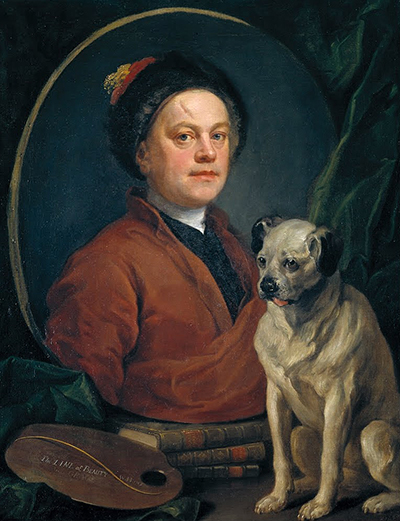William Hogarth completed his artwork Painter and His Pug in 1745. He began painting the self portrait in the 1730s, and wanted to depict himself in his formal attire.
He changed his mind during the process, and decided to paint himself in his informal clothing instead. He also decided to add his beloved pug, called Trump. In the painting, Hogarth is shown in a framed artwork, with Trump sat in front, and some books and a paint palette are placed beside him. There is a piece of cloth behind Trump, and it appears to be coming out of the painting of Hogarth. On the palette, he has drawn a Line of Beauty, which is a term that originated from Hogarth's work, and is a curved line with an S shape, which he wrote about in his book Analysis of Beauty. He states that it represents liveliness and activity, when compared to other lines, such as straight and parallel. The painting can now be seen at the Tate Gallery.
Hogarth's artistic career began as an apprentice engraver with Ellis Gamble. When he was young, his father was imprisoned for five years, because of debts he owned, and it is thought this influenced some of his darker paintings. He became a member of the Rose and Crown Club, alongside Peter Tillemans, Michael Dahl, and George Vertue, amongst other artists. Another honour bestowed on William Hogarth was becoming the Serjeant Painter to the King of England, from 1757 until he died in 1764. This position of court painter was highly prestigious, and very lucrative for Hogarth. He was also a popular portrait painter, and was paid vast amounts of money for this. He famously painted the actor David Garrack, in costume as Richard III, and was paid £200 for his work, which was more than any other English artist at the time. The painting can still be viewed at the Walker Art Gallery in Liverpool.
Hogarth influenced others through his work, most famously John Collier, who became known as the Lancashire Hogarth. David Garrick wrote an inscription for his tombstone, and his house in Chiswick, London is now a museum, with the roundabout next to it named Hogarth Roundabout. He also influenced literature, as Russell Banks wrote a fictional short story about Hogarth, and he was also the lead character in the play The Art of Success, by Nick Dear.




